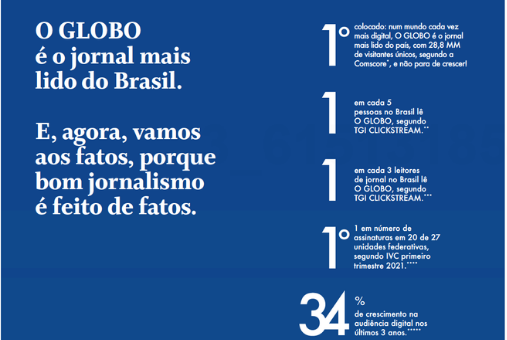On April 22, an article in Rio de Janeiro newspaper O Globo said: “There is no doubt: O GLOBO is the most read newspaper in Brazil.” The following day, however, the São Paulo-based Folha de S.Paulo replied: “Audience data for the 1st quarter reaffirm Folha's leadership”. In addition to publishing articles, the two outlets have invested in advertising campaigns that place them as leaders among Brazilian newspapers. But, who is right?
The two newspapers make different comparisons, using different criteria. O Globo uses as its main metric the number of unique visitors to its digital platforms in March 2021, as measured by Comscore: 29.8 million versus 23.2 million for Folha. O Globo also highlights the number of pages visited in March: 195.2 million against 192.2 million for Folha, also from Comscore.

Who's right? O Globo says it is the most widely-read newspaper in Brazil and launched a campaign that positions itself as ‘a national newspaper’
Folha presents the monthly average from January to March, also according to Comscore. It discloses having, by that criterion, 207.5 million page views, ahead of Globo’s 170 million. The newspaper claims to have reached 238 million page views in March alone, that is, different from the 192 million that O Globo attributes to it.

In response, Folha published an article and also launched a campaign to reaffirm that it is in fact the leader of the newspaper market in Brazil
According to O Globo, “Folha adds to this metric the audience of Piauí magazine, hosted on its website, but which does not belong to Grupo Folha. In the data released by the daily, the numbers of the newspaper ‘Agora São Paulo,’ a popular brand of the São Paulo group, are also counted. With the data of these different brands added to those of Folha, the newspaper accounts for 237.7 million pageviews.”
“All of those mentioned are content hosted on the Folha website, as well as dozens of blogs and columns. This month, O Globo announced that it will host the audience of Época magazine on its website. It is within the rules of the market, there is nothing abnormal,” Folha's editor-in-chief, Sérgio Dávila, told LatAm Journalism Review (LJR).
Folha also highlights the time spent by readers on its platforms, with 283 million minutes in the monthly average between January and March, according to Comscore. O Globo appears with 192 million.
Another indicator released by Folha is the paid audience, that is, subscriptions and the sale of single copies. According to data from the Communication Verifier Institute (IVC, for its acronym in Portuguese), Folha sold 352,459 paid daily copies, against 348,461 of Globo. The IVC numbers add the circulation of both print and digital editions.

Marcelo Rech, from ANJ: ‘the audience becomes valuable when it is converted into subscriptions’
“This search for national space is extremely positive. (...) It is a sign of victory. The national space with 200 million inhabitants is an interesting market, from the point of view of the audience, but it is a kind of revival of the valorization of professional information, as a central element in the communication market,” Marcelo Rech, president of Brazil’s National Association of Newspapers (ANJ), told LJR.
ANJ, as an entity that represents newspapers, does not merit the discussion, but Rech recognizes that establishing a single metric, or set of metrics that everyone is satisfied with, is a difficult task.
“In the case of the newspaper, there are three major platforms that are print, computer and cell phone, speaking very crudely. How do I calculate the common metric of these three? We have already tried at ANJ to make a measurement, it is not easy, nor without controversy. From a personal point of view, from my experience, it is that the audience is not just quantity, it is quality,” Rech said.
Researcher Lívia de Souza Vieira, professor in the communication school at the Federal University of Bahia, studies the use of digital metrics by news media, and calls the current dispute between Folha and Globo a result of what the academy classifies as "online confusion."
“The internet has inaugurated a new way of measuring audience in journalism. Because there was always a measurement by population sampling. Print newspapers used to carry out telephone surveys with their subscribers. It had copies sold, but you couldn't tell how many people read them. Today, it is much more sophisticated and specific,” Vieira told LJR.
The researcher immersed herself in the subject for her doctoral thesis, “Editorial metrics in online journalism: Ethics and professional culture in relationship with active audiences,” in which she investigates the changes that occurred in newsrooms from the possibility of accurately measuring each interaction the reader has with the publication in the digital environment.
“Depending on the company you use to measure this data, you may have different numbers. And as they are so close to each other, online confusion further increases. Quantitative metrics are important in the dispute for positioning in the market, but if you look at the consumption of the reader, it is not so important,” Vieira said. "What is more relevant, being more read or having more subscribers?"
The answer, according to experts heard by LJR, depends on the outlet, its coverage area, the target audience and its monetization strategy. In general, according to Vieira, smaller and less prestigious outlets are more dependent on the click to sell advertising. Larger outlets, according to her, understood that the click does not guarantee reading, sharing or engagement.

Lívia Vieira (UFBA): subscribers are more committed readers and loyal to the outlet
“To talk about which is the largest outlet in Brazil, a more reliable metric is that of subscribers. It tells me it has readers who pay for journalism. They are committed readers, who decide to pay, are loyal, and not accidental readers,” Vieira said, stressing that there is no consensus on the subject.
In a similar assessment, Rech, who worked for more than 30 years at Grupo RBS and now works as a consultant, states that in addition to quantity, the quality of the audience has a great weight for newspapers as a business and this refers to the audience's ability to buy subscriptions or attract advertising.
“The audience alone is nothing from an economic point of view. The audience becomes effective when it is converted into subscriptions. The audience needs to be converted and this is measured by quality, the ability to convert subscriptions or advertising,” Rech said. "Of course, in a wide audience, you have a greater chance of conversion."
National newspapers and local coverage
In the midst of the dispute between Folha and O Globo, researcher Rogério Christofoletti, responsible for the Journalistic Ethics Observatory (Objethos) of the Federal University of Santa Catarina (UFSC), points out that the positioning of newspapers as national outlets does not necessarily mean they have national journalistic coverage.

Rogério Christofoletti (UFSC): ‘I am curious to see how they will offer national content that justifies all this marketing’
“It is not enough to reach all parts of the country; a national newspaper has to bring content from all states, from all corners. Neither Folha nor O Globo has enough branches. I am curious to see how they will offer national content that justifies all this marketing,” Christofoletti told LJR.
Folha and O Globo are based in São Paulo and Rio de Janeiro, the two largest cities in the country, where they maintain the main part of their operations. Brasília also has considerable teams because it is the federal capital and the center of political power.
“The country is rife with news deserts, and that needs to be tackled. It is not enough that O Globo and Folha want to be national newspapers. If they do not offer content with that scope, the reader will not be convinced that they are really national," Christofoletti said. “If the reader from Paraíba, for example, does not see himself in the news, why would he remain a subscriber? This is a challenge for anyone who wants to be national.”
Editor's note: LJR made contact with Editora Globo, which publishes the newspaper O Globo, and asked for an interview with a representative of the company, but they declined to respond.